The information on this page has been assembled by Frank Sharman. Some
of the material has been gleaned from
www.englishmetalware.com
, the art metalware web site. We are grateful to Gregory J.
Kolojeski for permission to use this material. Readers of this page
should visit that site. Except where otherwise acknowledged all photos
on this page are from a private collection in Wolverhampton.
When Sankeys started to produce art metalware is not known
but it seems possible that they did so about 1890 when, according to the
19th century Bilston historian, Lawley, "the firm patented a new
process for the decoration of tin plates, and during the last two years an
entirely new branch has been added in the manufacture by this process of
their patent "Neptune Art Ware," comprising trays, waiters, candlesticks,
bread baskets, &c., in various shapes and of different designs." The
art nouveau styles found on many pieces tends to confirm this as a likely
date. Gregory Kolojeski has noted Sankey's registered designs from 1896
through to 1914.
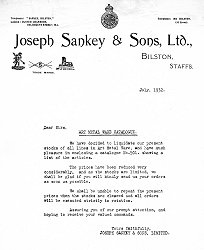 |
In July 1932 Sankeys sent out this letter with a catalogue.
The letter says "We have decided to liquidate our present stocks
of all lines of Art Metalware" and it says the prices "have been
reduced very considerably". A sticker attached to the
catalogue gives the discount as 50%. The letter also says
"We shall be unable to repeat the present prices when the stocks
are cleared". Whilst this leaves open the possibility that
production of art metalwares was to continue, this is far less
likely than this being the last fling. |
| The catalogue which this letter accompanied is shown right.
It is dates May 1932 and contains 26 copiously illustrated
pages. Whilst not every one of their known art metalware
products is listed, a very large number of them is and from all
categories. This confirms the statement that they were
liquidating all stocks and that 1932 is the best date for the
end of production of these goods. Catalogue and letter
from a private collection. |
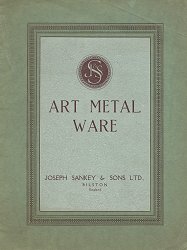 |
Sankeys used three trade marks: the Sphinx, the figure of
Neptune and the letter S in a diamond pattern. The Sphinx and
Neptune have both been found on art metalware but the commonest form of
marking seems to have been variations of the letters JS&S or JS&SB. It
is possible that the "B" stands for Bilston.
 |
The two marks, top left, appear on ewers (in a
private collection in Wolverhampton).
The other two marks are from the Artmetalware web site. |
Note that another Wolverhampton company, John Shaw and
Sons, also sometimes put the letters J S & S on their products. But
these were a different class of product and, so far as is known, Shaws never
made art metalware. The letters JS&S have been noted on, for example,
a brass blow lamp.
Sankeys produced a wide range of art metalware items and the full
extent of their production is not yet known. However a catalogue
produced by the company in 1910 probably covers most of the items
produced. (Wolverhampton City Archives, call number DX302).
The catalogue is titled "Stamped and Pressed Holloware. Art Metal Work.
Embossed and Engraved Sheets".
It starts with a wide selection of practical, utilitarian domestic wares.
It then comes to what might be termed art metalware. It is not clear
as to what items are produced in what combinations of materials, finishes
and designs. However those mentioned are copper, brass, caspian
silver, electro-plate, nickel-plate and oxidised silver.
There is a separate section headed "Neptune Art Ware" and this must be
the patented process referred to by Lawley. Nearly all of the items in
this section are waiters but there are also fruit dishes and, surprisingly,
dust pans. It appears that this ware consists of metal sheet embossed
all over with elaborate patterns. Amongst the items are round and oval
waiters which are offered in a silver finish or "coloured and silver" or
"coloured and gold" and some are "coloured in relief". There is no
mention of what colours are available. But the entries suggest that
this Neptune process could include some sort of finish in colours but,
whether the colour is enamel or what, there is no way of telling.
Neptune art ware is also available as embossed sheets. This
suggests that Sankeys were selling the processed sheets to anyone who wanted
to have a go at producing art metalware themselves.
To give a list of what the catalogue offers in copper, brass and other
metals and finishes would be very boring. So here goes.
cake baskets, breakfast trays, afternoon tea trays, crumb sets, scoops
and brushes, bread trays, bread boards, tea pot stands, finger bowls,
cheese butter and biscuit dishes, hot water jugs (mostly with or without
lids), hot water cans, match holders, ash trays, fern pots, panels and
finger plates, photograph frames, string boxes, desk pads, fire guards,
umbrella stands, waste paper baskets, toilet trays, brushes, mantle
strips, tea caddies, candle sticks, coal boxes and scuttles.
The following illustrations show at least something of the range.
| A tray in copper. These large and weighty trays,
especially those with some sort of art nouveau or arts and crafts
attributes, are much beloved by antique dealers, who charge fancy prices
for them. |
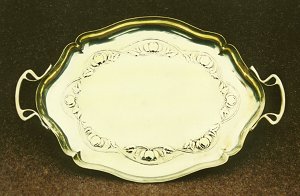 |
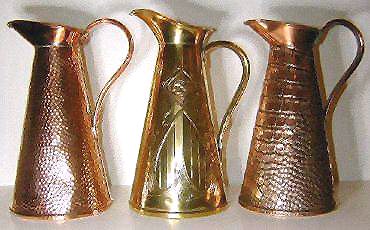 |
To judge by the numbers still around, these jugs or
ewers were a popular line. The catalogue refers to them simply as
"hot water jugs". They came in at least three finishes, shown
here, from left to right: hammered, art nouveau and lizard skin.
Photo courtesy the English metalware website. |
| This lizard skin hot water jug, size 3, has the Neptune
trade mark on its base. |
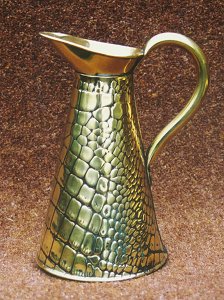 |
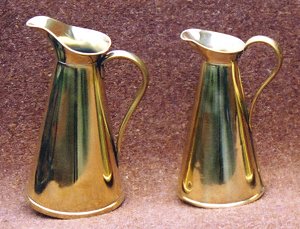 To modern tastes these plain versions may look
more elegant than the patterned ones.
To modern tastes these plain versions may look
more elegant than the patterned ones.
Above are two copper jugs, one size 4, the
other size 3. |
|
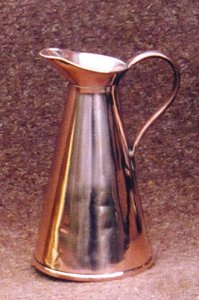
A copper jug, size 3. |
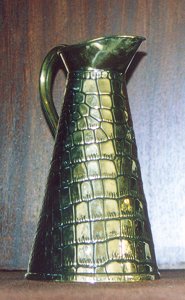 |
Presumably all designs were available in both metals.
Here are size 4 lizard skin hot water jugs in copper and brass. |
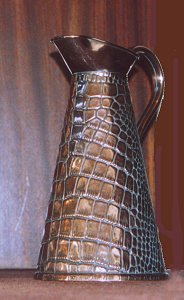 |
| These hot water jugs came in at least five sizes.
The size number usually seems to be stamped on the base. There
were also two handle designs, shown here on brass art nouveau jugs.
Photo courtesy the English metalware website. |
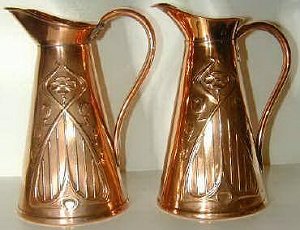 |
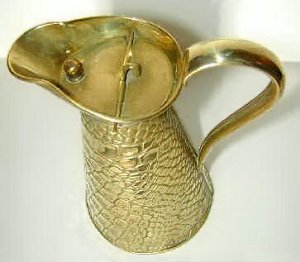 |
A further variation was provided by a flip top lid,
available, according to the catalogue, on nearly all sizes and styles of
the hot water jugs. Photo courtesy the English metalware website. |
| These look like tankards but are called hot water jugs
in the catalogue. They came in both metals, at least two handle
and thumb catch styles, and at least two decorative patterns. |
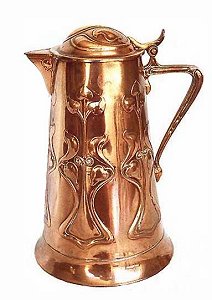 |
 |
These tea caddies show both metals, two patterns and two sizes. There may
have been more variations. Courtesy of the English metalware website. |
| A chamber candlestick. At the time it was produced, such a
piece was for practical use in lighting your way to bed. Courtesy of the English metalware
website. |
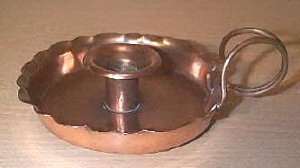 |
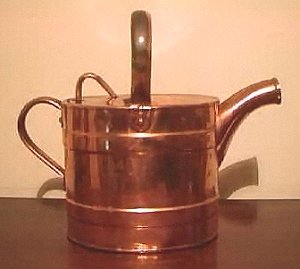 |
This copper hot water can is plain but is also known in
a honeysuckle design. Courtesy of the English metalware website. |
| A fine copper kettle. Courtesy of
|
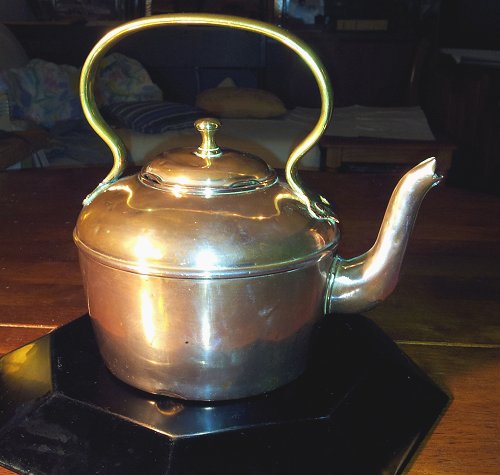 |
| A large crumb tray in brass. From Frank Sharman's
collection.
Crumb trays could usually be bought with or
without a matching brush. The most usual practice was to use a
crumb tray with a folded napkin, not a brush. The catalogue shows
brushes with all crumb trays but there are fewer designs of brush than
there are of crumb trays - it seems that the nearest match was used to
make up a set. |
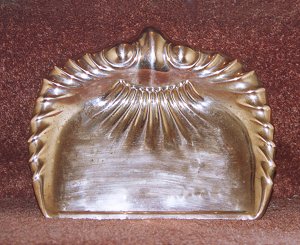 |
 |
A plain crumb scoop in brass. This very plain style does not appear in the
catalogue but it is marked JS&S. From Frank Sharman's
collection. |
| This crumb tray may be in the original Neptune art
metal. It is embossed with an overall pattern.
It also
has to be said that the finish is unnaturally bright and very red. |

|
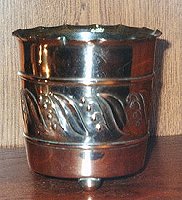 |
Two cache pots, each about 4" high. Left:
on three bun feet and with lily of the valley frieze.
Right: pierced frieze and with oak leaf and acorn frieze. |

|
It is difficult to say where art metalware ends and an attractive design of a
utilitarian piece begins.
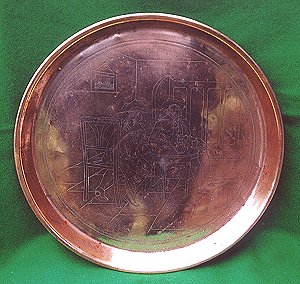 |
This is said to be a pub tray. Stamped into it is a
line drawing of two men in roughly 18th century clothes, seated on a
chair and a settle.
It was found in Australia. It may have got their with an
immigrant's effects; or Sankeys may have exported it. |
| A Sankey's jug in the same design as the copper and
brass versions but in bright chrome. Clearly of a much later date
and showing the Sphinx trade mark on its base. |
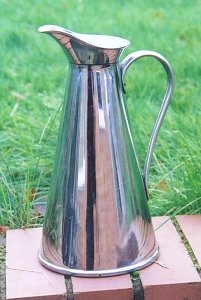 |
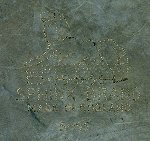 |
This is the trade mark on the base of the chrome ewer. It is
just as faint in the original, being only very lightly impressed. |
At some point Sankeys also started to produce stainless
steel utensils of a plain but attractive design:
| Stainless steel frying pan, bowl and tankard. From
Kath Kiely's kitchen. |
 |
 |
Return to
previous page |
|
|

